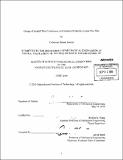Design of parallel plate condensers with sintered wicks for a loop heat pipe
Author(s)
Koveal, Catherine Helene
DownloadFull printable version (24.12Mb)
Other Contributors
Massachusetts Institute of Technology. Dept. of Mechanical Engineering.
Advisor
Evelyn N. Wang.
Terms of use
Metadata
Show full item recordAbstract
New innovations and integrations of existing cooling methods are needed to enable high performance operation of high power electronic equipment. Air-cooled solutions are attractive due to their simplicity; however these solutions are normally limited to low power dissipation rates. Through a novel design and integration of a blower and a compact heat exchanger, low thermal resistance and high efficiency heat transfer can be achieved. This device combines the increased surface area of a finned geometry with the isothermal heat transfer of a heat pipe and the low speed operation of integrated fan blades to dissipate 1000 W using 30 W of input electrical power in a 10x1Ox10 cm3 volume. This thesis focuses on the design and experimental validation of the 2.5 mm thick, 200 cm2 surface area flat plate condenser repeated in parallel in the loop heat pipe structure. The condenser was designed to ensure even mass flow distribution and phase-separation within each layer. To better understand the physics and governing parameters within the thin geometry of the condenser, an experimental setup was designed and fabricated that allowed for visualization and measurement of the condensing flow. Experimental studies were conducted to explore condensation within open and sinter channel geometries while varying flow rate, backside cooling, and gravitational orientation. Open channel flow exhibited sensitivity to cooling heat transfer and orientation resulting in a variable condensing length connected to a sharp drop in surface temperature and gravity-dominated flow patterns. In contrast, testing with sinter wick in the channel demonstrated an isothermal surface over the length of the condenser and gravitationally independent flow stability due to separation of the liquid and vapor phases. The addition of a sub-cooling length within the sinter channel was shown to retain high isothermal temperatures upstream while reducing condensate temperature below saturation before the condenser outlet. However, to prevent large pressure drops incurred by flow through the sinter, balance is required between desired sub-cooling and sinter permeability. This work demonstrates the potential for a condenser design with a sintered wick and a sub-cooling section to mitigate the failure modes of parallel condensers. These results serve as guidelines for the continued development of the parallel plate condensers for the loop heat pipe integrated into the compact heat exchanger.
Description
Thesis (S.M.)--Massachusetts Institute of Technology, Dept. of Mechanical Engineering, 2010. Cataloged from PDF version of thesis. Includes bibliographical references (p. 129-131).
Date issued
2010Department
Massachusetts Institute of Technology. Department of Mechanical EngineeringPublisher
Massachusetts Institute of Technology
Keywords
Mechanical Engineering.